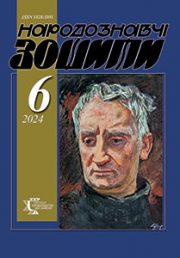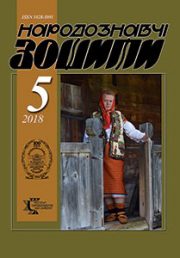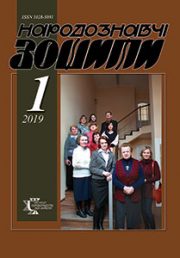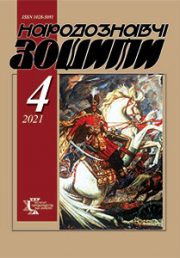The Ethnology Notebooks. 2023. № 3 (171), 511—524
UDK 392.51+393.95(477)
DOI https://doi.org/10.15407/nz2023.03.511
WEDDING RITUAL TREE AMONG UKRAINIANS: FUNCTIONS AND MYTHOLOGICAL MEANING
SILETSKYI Roman
- ORCID ID: https://orcid.org/0000-0002-1451-5908
- doctor of Sciences in History, professor,
- Department of Ethnology,
- Ivan Franko National of Lviv,
- 1, Universytetska Street,79000, Lviv, Ukraine,
- Contacts: e-mail: r.sileckyj@gmail.com
Abstract. The article is devoted to the traditional wedding ceremony of Ukrainians, which preserves many archaic features and has numerous local features.
The object of attention is the ceremonial wedding tree («giltse», «wiltse», «kositsya», etc.), as one of the most stable and important attributes of the marriage ritual of Ukrainians and other European (primarily Slavic) peoples.Despite the interest of ethnologists (ethnologists, folklorists) in the traditional wedding rituals of the Ukrainian people, as evidenced by numerous publications, the ritual wedding tree, in particular its ritual functions and semantics, remains unexplored. It is this circumstance that actualizes the chosen topic of the article. In the proposed attention of the reader of the publication, a complex of ritual actions, beliefs, ritual regulations related to the manufacture and use of twigs in the wedding ceremony is considered.In the proposed attention of the reader of the publication, a complex of ritual actions, beliefs, ritual regulations related to the manufacture and use of twigs in the wedding ceremony is considered.
The purpose of the study is to clarify the function of the ceremonial wedding tree in the traditional marriage ritual of Ukrainians and its semantics — the mythological content of the said ceremonial attribute.
The object of study is the traditional wedding ceremony of Ukrainians.
The subject of the study is the ritual functions of the wedding branch as an attribute of the wedding ceremony, the clarification of the philosophical foundations of the origin of the ritual tree.
The territorial boundaries of the study cover the entire settlement area of the Ukrainian ethnic group (Volyn, Polissia, Middle Dnipro region, Slobozhan region, Pokuttia, Carpathians, Steppe Ukraine) with the involvement of comparative material from Slavic and non-Slavic peoples of Europe.
The chronological framework of the study is mainly limited to the 19th — the beginning of the 21st centuries, which is determined by the state of the source base.At the same time, the conclusions go far beyond the specified chronology.
Research methods — the principle of historicism, historical-comparative method, typological, complex and retrospective analysis, historical reconstruction were used to achieve the goal.
Keywords: ethnology, Ukrainians, wedding rites, funeral rites, memorial signs, beliefs, memorial customs.
Received 26.04.2023
REFERENCES
- Borysenko, V.K. (1988). Wedding customs and rites in Ukraine: Historical and ethnographic research. Kyiv: Naukova dumka [in Ukrainian].
- Sumtsov, N.F. (1996). About predominantly Russian wedding ceremonies. In Sumtsov N.F. Symbols of Slavic rites. Selected works (Pp. 6—157). Moscow: Vostochnaya literatura; RAS [in Russian].
- Vovk, Hv. (1995). Ethnographic features of the Ukrainian people. In Vovk Hv. Studies in Ukrainian ethnography and anthropology (Pp. 39—218). Kyiv: Mystetstvo [in Ukrainian].
- Vovk, Hv. (1995). Marriage ritual and rites in Ukraine. In Vovk Hv. Studies in Ukrainian ethnography and anthropology (Pp. 219—323). Kyiv: Mystetstvo [in Ukrainian].
- Zelenin, D.K., & Tsyvina, K.D. (1991). Eastern Slavic Ethnography. Moscow: Nauka [in Russian].
- Zdorovega, N.I. (1974). Essays on wedding rituals in Ukraine. Kyiv: Naukova dumka [in Ukrainian].
- Nesen, I.I. (2005). Wedding ritual of Central Polissia: traditional structure and relict forms (middle of the 19th — 20th centuries). Kyiv: Center for the Protection of Cultural Heritage from Emergency Situations [in Ukrainian].
- Kushnir, V.G., & Petrova, N.O. (2008). Traditional wedding rituals of the Ukrainians of Odesa (20—80s of the XX century). Odesa [in Ukrainian].
- Makhovska, S. (2014). «Oh, from behind the mountains of old women…»: Wedding traditions of Slobozhanshchyna of the end of the 19th — beginning of the 21st century. Kyiv [in Ukrainian].
- Gura, A.V., & Tolstoy, N.I. (Ed.). (1999). (Ceremony tree) Wedding tree. Slavic Antiquities: Ethnolinguistic Dictionary:in Five Volumes (T. 2: D—K (Kroshki), pp. 83—84). Moscow: International Relations [in Russian].
- Gura, A.V. (2012). Marriage and family in Slavic folk culture: Semantics and symbolism. Moscow: Indryk (Traditional spiritual culture of the Slavs: Contemporary studies) [in Russian].
- Agapkina, T.A. (2019). Trees in the Slavic folk tradition: Essays. Moscow: Indryk (Traditional spiritual culture of the Slavs: Contemporary studies) [in Russian].
- Hrushevskyi, M. (1993). History of Ukrainian literature: in 6 vols., 9 books (Vol. 1: Literary monuments of Ukraine). Kyiv: Lybid [in Ukrainian].
- Kutelmah, K. (1997). Commemorative motifs in the calendar rites of Polishchuks. Polissya of Ukraine: materials of historical and ethnographic research (Vol. 1: Kyiv Polissia. 1994, pp. 172—203). Lviv [in Ukrainian].
- Siletsky, R. (2011). Traditional building rituals of Ukrainians: a monograph. Lviv: Ivan Franko National University [in Ukrainian].
- Galaichuk, V., Pylypchuk, S., & Siletskyi, R. (2012). Wedding in the village of Sapanovi, Kremenets district, Ternopil region. Bulletin of Lviv University. The series is historical (Vol. 47, pp. 344—364). Lviv [in Ukrainian].
- Demchenko, I. (1970). Wedding in the town of Monastyryshche, Lypovetsky District, Kyiv Province. Wedding: in two books (Book 1, pp. 147—219). Kyiv: Naukova dumka [in Ukrainian].
- Skrypnyk, H. (Ed.). (2016). Ethnographic image of modern Ukraine: Corpus of expeditionary materials (Vol. 4:Wedding rituals). Kyiv: IMFE Publishing House [in Ukrainian].
- Archive of Ivan Franko National University of Lviv (hereinafter — Ivan Franko LNU Archive). F. R-119. Op. 17. Reference 205-E [in Ukrainian].
- Ternovskaya, O.A., & Tolstoy, N.I. (Ed.). (1995). Baba. Slavic Antiquities: Ethnolinguistic Dictionary: in five vol. (T. 1: А—Г, pp. 122—123). Moscow: International Relations [in Russian].
- Sedakova, I.A. , & Tolstoy, N.I. (Ed.). Ded. (1999). Slavic Antiquities: Ethnolinguistic Dictionary: in five vol. (T. 2: D—K (Kroshki), pp. 41—43). Moscow: International Relations [in Russian].
- Kostenko, L. (2011). Wedding ceremony in the village of Peregonivka, Obukhiv district, Kyiv region. Sources for Ukrainian ethnology: Field research materials (Vol. 1, pp. 237—252). Kyiv: Zadruga [in Ukrainian].
- Vinogradova, L.N., Plotnikova, A.A., & Tolstoy, N.I. (Ed.). (2009.). Ryazhenie. Slavic Antiquities: Ethnolinguistic Dictionary:in five vol. (T. 4: P (Crossing the water) — C (Sieve), pp. 519—525). Moscow: International relations [in Russian].
- Chubynskyi, P. (1995). The wisdom of the ages: (Ukrainian folklore in the creative heritage of Pavel Chubynskyi): in 2 books. (Book 2). Kyiv: Mystetstvo [in Ukrainian].
- Dymnych, N.Ya., & Dymnych, N.Ya. (1970). A wedding in the village of Kremesh, Horokhiv district. Wedding: in two books (Book 2, pp. 7—72). Kyiv: Naukova dumka [in Ukrainian].
- Verkhovynets, V.M. (1970). A wedding in the village of Shpychyntsi, Skvyr district, Kyiv province. Wedding: in two books (Book 1, pp. 220—280). Kyiv: Naukova dumka [in Ukrainian].
- Kutelmah, K. (1999). Agrarian motifs in the Polish pike calendar rituals. Polissia of Ukraine: materials of historical and ethnographic research (Vol. 2: Ovruchina. 1995, pp. 191—210). Lviv [in Ukrainian].
- Archive of the Ivan Franko National University. F. R-119. Op. 17. Reference 522-E [in Ukrainian].
- Galaichuk, V. (2021). Traditional demonological ideas of Ukrainians about household spirits: a monograph. Lviv [in Ukrainian].
- Lozynskyi, Y.I., & Kirchyv, R.F. (Ed.). (1992). Ukrainian wedding. Order and introduction. Kyiv: Naukova dumka [in Ukrainian].
- Kolessa, F. (2001). Beliefs about the soul and the afterlife in Ukrainian funeral and memorial rites. Notes of the Shevchenko Scientific Society (Vol. CCXLII: Proceedings of the Section of Ethnography and Folkloristics,pp. 7—82). Lviv [in Ukrainian].
- Ravlyuk, V. (Ed.). (1970). A wedding in the village of Oreltsi, Snyatyn district, Stanislav region. Wedding: in two books (Book 2, pp. 183—231). Kyiv: Naukova dumka [in Ukrainian].
- Archive of the Ivan Franko National University. F. R-119. Op. 17. Reference 259-E [in Ukrainian].
- Varhol, N. (1992). People’s imagination about a tree. Scientific collection of the Museum of Ukrainian Culture in Svydnik (Pp. 228—244). Pryashiv [in Ukrainian].
- Boplan, G.L. de. (1990). Description of Ukraine, several provinces of the Kingdom of Poland, stretching from the borders of Muscovy to the borders of Transylvania, together with their customs, way of life and warfare. Kyiv: Naukova dumka; Cambridge (Mass.): Ukr. of science Institute of Technology [in Ukrainian].
- Siletskyi, R. (2019). «They planted a sycamore and a spruce above the Cossack, and a red viburnum on the girl’s head…» (Burial under a tree: a remnant of an ancient tradition among Ukrainians). Bulletin of Lviv University. The series is historical. Special edition for the 75th anniversary of Professor Kostyantyn Kondratyuk (Pp. 647—672). Lviv: LNU named after Ivan Franko [in Ukrainian].
- Siletsky, R. (2022). Forest in folk demonological ideas of Ukrainians. Scientific notebooks of the Faculty of History of Lviv University. Collection of scientific works (Issue 23: Anniversary issue in honor of Bohdan Yakimovich, pp. 473—492). Lviv [in Ukrainian].
- Vynnychuk, L., & Ronin, V.K. (1988). People, manners and customs of Ancient Greece and Rome. Moscow: Higher School [in Russian].
- Siletskyi, R. (2008). Heating devices of public housing in the Middle Polissia: structural, functional and worldview aspects. Bulletin of Lviv University. The series is historical (Issue 43, pp. 134—183). Lviv: LNU named after Iv. Franka [in Ukrainian].
- Ivanova, Yu.V., & Krasnovskaya, N.A. (1990). Some results of the study of marriage and wedding rites in the nations of foreign Europe. Marriage among the peoples of Western and North-Western Europe (Pp. 156—169). Moscow: Nauka [in Russian].
- Gantskaya, O.A. (1988.). Poles. Poverty among the peoples of Central and South-Eastern Europe (Pp. 8—32). Moscow: Nauka [in Russian].
- Gratianskaya, N.N. (1988). Czechs and Slovaks. Poverty among the peoples of Central and South-Eastern Europe (Pp. 33—65). Moscow: Nauka [in Russian].
- Kashuba, M.S. (1988). People of Yugoslavia. Poverty among the peoples of Central and South-Eastern Europe (Pp. 80—134). Moscow: Nauka [in Russian].
- Bromley, Y.V., & Kashuba, M.S. (1982). Marriage and family among the peoples of Yugoslavia. Moscow: Nauka [in Russian].
- Ivanova, R., & Markova, L.V. (1988). Bolgary. Poverty among the peoples of Central and South-Eastern Europe (Pp. 135—159). Moscow: Nauka [in Russian].
- Rickman, E.A. (1988). Romanians. Poverty among the peoples of Central and South-Eastern Europe (Pp. 160—181). Moscow: Nauka [in Russian].
- Rudensky, N.E. (1989). Hungary. Marriage among the peoples of Western and Southern Europe (Pp. 66—88). Moscow: Nauka [in Russian].
- Anfertiev, A.N. (1988.). Greeks. Poverty among the peoples of Central and South-Eastern Europe (Pp. 206—228). Moscow: Nauka [in Russian].
- Filimonova, E.D. (1989). Nemtsy. Marriage among the peoples of Western and Southern Europe (Pp. 5—43). Moscow: Nauka [in Russian].
- Filimonova, E.D. (1989). Austrians. Marriage among the peoples of Western and Southern Europe (Pp. 44—65). Moscow: Nauka [in Russian].
- Ivanova, Yu.V., & Pokrovskaya, L.V. (1989). Peoples of France. Marriage among the peoples of Western and Southern Europe (Pp. 177—209). Moscow: Nauka [in Russian].
- Reshina, M.I. (1989). People of Belgium and the Netherlands. Marriage among the peoples of Western and Southern Europe (Pp. 210—238). Moscow: Nauka [in Russian].
- Berezyna, E.A., & Morozova, M.N. (1990). Shvedy. Marriage among the peoples of Northern and North-Western Europe (Pp. 44—56). Moscow: Nauka [in Russian].







